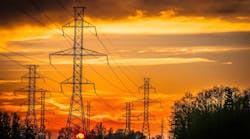Smaller-scale, natural-gas-fired on-site generation has an increasingly important role to play as markets for distributed energy resources (DERs) mature.
While Ameren’s breakthrough microgrid at the University of Illinois campus in Champaign, Illinous, U.S., is one of the most technologically advanced facilities of its kind and has achieved an impressive roster of “firsts” for a North American microgrid, two important firsts that have been under-emphasized are the systems engineering approach being employed and the key role played by natural gas.
It is almost as if the press coverage is in inverse proportion to the various sizes of the elements in Ameren’s microgrid, with the large natural-gas element getting the least coverage. Sure, the facility’s 100-kW wind turbine, 125-kW solar array and 250 kW of battery storage are important and interesting, but the facility’s 1000-kW Caterpillar natural-gas-fired generator not only represents more than twice the combined capacity of those other three elements. Furthermore, the generator also helps the facility to meet many of its key use cases and reliability hurdles, especially when it comes to reliably meeting peak demand.
Taking a Peek at Peak Demand
Perhaps part of the reason gas generally gets short shrift is because the general public often lacks sufficient appreciation of peak pricing for electricity. Is peak pricing of electricity an exception to the supposed rule that nobody likes to pay more for something than they have to? Will most electric utility customers simply continue their high-peak-usage patterns, whether knowingly or unknowingly?
A lot of the upcoming and exciting shifts for our electric grid involve developments whose growth potential will address the high costs utilities face in order to reliably meet peak electricity demand. Demand response, electric vehicles, home energy networks and microgrid markets will all be growing more rapidly as we move forward to meet the coming distributed energy future.
In the electric utility industry, we have the opportunity to shift generation and load dynamically and thus reduce or shift peak demand.
In recent discussions with Alex Rojas, director of distributed technologies at Ameren, I got a good reminder of how a microgrid could pay for itself fairly short period of time if its owner sells power back into the grid during a few of each year’s highest peak demand periods.
Rojas spoke about how engineers need to innovate. He said Steve Jobs did not invent the iPhone by surveying customers. And Rojas has a clear sense that we need to avoid exclusively focusing on ROI-centric approaches, or by designing around the maximum price premium customers say they may be willing to pay.
According to Rojas, Ameren’s shift to a new systems engineering approach is “taking what has been technically possible based on pilots and smaller programs in recent years, and looking at what needs to be in place end-to-end in order to fit all the key pieces together on a large scale.” He explains, “We are sharpening our tools because the amount of real-time data that will be required to reliably operate the utility of the future will be many thousands of times greater than what we are dealing with now.”
Instead of our being worried about the coming flood of data, I suggest we see it as a positive surge, something utilities can ride upon to create new markets and value for us and our customers. And I suggest that, indeed, the answers to managing our future are imbedded in that data we can mine to come up with optimal energy solutions.
As we add more DERs, natural gas has a big role to play. But DERs and microgrid market growth will be hindered by the complex definitions we now have for time-of-use, real-time, variable and critical peak pricing.
To grow these markets, we need a little more than “marketing mojo.” We need to redefine our role with our present customers who, going forward, will be our partners and who will influence energy decisions as they use energy reductions, load shifting and on-site generation to help redefine our energy markets.
Rojas sees the installation of the microgrid as more than an energy platform to reach energy customers. It is also a beacon of light for the future of Ameren, as employees have the opportunity to visit the facility and learn what shape their personal futures might take.
Ameren’s microgrid at the University of Champaign, IL--an impressive roster of “firsts” for a North American microgrid:
- First to operate at utility-scale voltages between 4 kV and 34.5 kV;
- First serve live customer loads on an actual utility distribution feeder.
- First able to seamlessly transition the power source for an entire distribution circuit from exclusively distributed generation sources to the traditional grid through islanding.
- First to install a military-grade controller with Authorized to Operate (ATO) status from the Department of Defense.
- Passed recent milestone tests, by operating 100% in islanded mode, relying upon wind, solar, and battery storage for more than a 24 hour period.


